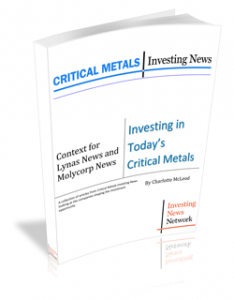This article was originally published on Scandium Investing News on September 17, 2014.
Scandium is not particularly rare on the Earth’s surface. In fact, it is more abundant than lead, mercury and precious metals.
However, it also has a low affinity for other minerals. That means it rarely manages to concentrate at higher grades alongside other metals, making commercially usable deposits of scandium very rare.
Even when it is found at elevated levels, processing can be difficult, leading to very few stable sources of the metal. Not surprisingly, that means there has been very little adoption of scandium in commercial applications.
 |
There Is No Guide to Critical Metals Investing That is More Concise, Clear and Authoritative.Download this FREE Special Report, Investing in Today’s Critical Metals – Context for Lynas News and Molycorp News. |
Current scandium production
The first reported large-scale scandium production was associated with Russian military programs. Details are lost to history, but Russians reportedly alloyed the metal with aluminum to make lightweight MIG fighter parts. Mining at these historic Russian production sites has ceased; however, stockpiles of scandium oxide and scandium master alloy remain in Russia. These stockpiles are rumored to be dwindling, but continue to be offered for sale on the market.
Today, most scandium is produced as a by-product of processing activities associated with the production of other metals, minerals or rare earths. It’s worth noting that this can make the market’s already tough-to-follow dynamics even more difficult, as secondary materials can be subject to reduced and intermittent production stoppages that are based more on the economics of primary products at the mine.
The principal scandium producing countries today are China, Russia, Ukraine and Kazakhstan. However, a number of junior mining companies in Australia are aiming to develop scandium deposits in New South Wales, including Scandium International Mining (TSX:SCY), Clean TeQ Holdings (ASX:CLQ) and Platina Resources (ASX:PGM).
Other companies are looking at the potential of producing scandium as a by-product. Texas Rare Earth Resources (OTCMKTS:TRER), for example, is looking to produce scandium as a by-product at its Round Top rare earths project. NioCorp Developments (TSXV:NB) has also included scandium in its resource estimate for its Elk Creek niobium project in Nebraska, although some have been hesitant regarding the portion of project’s revenues set to come from scandium oxide production.
Known production estimates
According to the US Geological Survey, the global trading volume of scandium is “very small,” and comes in at fewer than 10 tons per year. Neither the US Department of Commerce nor the International Trade Commission has specific data on trading for the metal.
Furthermore, the scandium market is disorganized. There is no formal buy/sell market today — the metal is not traded on an exchange and there are no terminal or futures markets.
Instead, the metal is traded between private parties, mostly at undisclosed prices and in undisclosed amounts. Therefore, understanding the precise volume of its production and trade is difficult, and independent estimations are more relevant.
Estimates from independent authors place the historic global market volume of scandium between 2 and 10 tons per year. The current level is thought to be higher, at least 15 tons for 2014. These estimates are based on levels of trader activity and interest, as well as the knowledge that some traders deal in scandium from very small operations.
The estimates also include scandium consumers believed to be sourcing their own scandium through small, controlled recovery operations, but don’t consider amounts of the metal contained in the master alloys currently being sold from Russian stockpiles.
 |
There Is No Guide to Critical Metals Investing That is More Concise, Clear and Authoritative.Download this FREE Special Report, Investing in Today’s Critical Metals – Context for Lynas News and Molycorp News. |
The opportunity
Despite the lack of known, stable scandium supply, scientists and engineers have been working hard to develop new products incorporating the metal. Scandium’s potential in high-tech applications is well documented:
- It can be used in the creation of stronger, corrosion-resistant, heat-tolerant and weldable aluminum alloys for lightweight aircraft and automobiles
- The metal has outstanding electrical properties and heat resistance valuable for solid oxide fuel cells
- Scandium has unique optical properties for high-intensity lamps
Aluminum alloys present the largest of these potential scandium applications. If only a tiny fraction (0.1 percent) of the annual aluminum market absorbed scandium in alloy at a 0.5 percent level, it would represent 350 tons in annual global scandium demand. Many observers believe global demand could reach this level in a relatively short time.
As John Kaiser of Kaiser Research has said, “there’s an enormous latent demand for scandium if it ever became available on a primary, scalable basis.”
This is the scandium opportunity. The lack of assured sources of supply and scalability of growth as the market expands are the remaining obstacles to a substantial market and a whole new family of high-performance aluminum materials and energy/lighting products.
The post Scandium Production: The Problem and the Opportunity appeared first on Investing News Network.